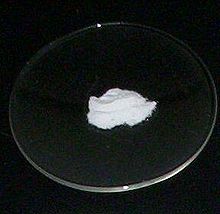
Back فلوريد السيزيوم Arabic سزیوم فلوئورید AZB সিসিয়াম ফ্লোরাইড Bengali/Bangla Fluorur de cesi Catalan Fluorid cesný Czech Caesiumfluorid German Φθοριούχο καίσιο Greek Zesio fluoruro Basque سزیم فلوئورید Persian Cesiumfluoridi Finnish

| |

| |
| Names | |
|---|---|
| IUPAC name
Caesium fluoride
| |
| Other names
Cesium fluoride
| |
| Identifiers | |
3D model (JSmol)
|
|
| ChemSpider | |
| ECHA InfoCard | 100.033.156 |
| EC Number |
|
PubChem CID
|
|
| RTECS number |
|
| UNII | |
CompTox Dashboard (EPA)
|
|
| |
| |
| Properties | |
| CsF | |
| Molar mass | 151.903 g/mol[1] |
| Appearance | white crystalline solid |
| Density | 4.64 g/cm3[1] |
| Melting point | 703 °C (1,297 °F; 976 K)[1] |
| Boiling point | 1,251 °C (2,284 °F; 1,524 K) (2,284 °F; 1,524 K) |
| 573.0 g/100 mL (25 °C)[1] | |
| Solubility | Insoluble in acetone, diethyl ether, pyridine and ethanol 191 g/100 mL in methanol. |
| Basicity (pKb) | −744 kJ/mol |
| -44.5·10−6 cm3/mol[2] | |
Refractive index (nD)
|
1.477 |
| Structure | |
| cubic, cF8 | |
| Fm3m, No. 225[3] | |
a = 0.6008 nm[3]
| |
Lattice volume (V)
|
0.2169 nm3[3] |
Formula units (Z)
|
4 |
| Octahedral | |
| 7.9 D | |
| Thermochemistry | |
Heat capacity (C)
|
51.1 J/mol·K[4] |
Std molar
entropy (S⦵298) |
92.8 J/mol·K[4] |
Std enthalpy of
formation (ΔfH⦵298) |
-553.5 kJ/mol[4] |
Gibbs free energy (ΔfG⦵)
|
-525.5 kJ/mol[4] |
| Hazards | |
| Occupational safety and health (OHS/OSH): | |
Main hazards
|
toxic |
| GHS labelling: | |
  
| |
| Danger | |
| H301, H311, H315, H318, H331, H361f | |
| P201, P202, P260, P261, P264, P270, P271, P280, P281, P301+P310, P301+P330+P331, P302+P352, P303+P361+P353, P304+P340, P305+P351+P338, P308+P313, P310, P311, P312, P321, P322, P330, P332+P313, P361, P362, P363, P403+P233, P405, P501 | |
| NFPA 704 (fire diamond) | |
| Flash point | Non-flammable |
| Safety data sheet (SDS) | External MSDS |
| Related compounds | |
Other anions
|
Caesium chloride Caesium bromide Caesium iodide Caesium astatide |
Other cations
|
Lithium fluoride Sodium fluoride Potassium fluoride Rubidium fluoride Francium fluoride |
Except where otherwise noted, data are given for materials in their standard state (at 25 °C [77 °F], 100 kPa).
| |
Caesium fluoride (cesium fluoride in American English) is an inorganic compound with the formula CsF. A hygroscopic white salt, caesium fluoride is used in the synthesis of organic compounds as a source of the fluoride anion.[5] The compound is noteworthy from the pedagogical perspective as caesium also has the highest electropositivity of all commonly available elements and fluorine has the highest electronegativity.
- ^ a b c d Haynes, William M., ed. (2011). CRC Handbook of Chemistry and Physics (92nd ed.). Boca Raton, FL: CRC Press. p. 4.57. ISBN 1-4398-5511-0.
- ^ Haynes, William M., ed. (2011). CRC Handbook of Chemistry and Physics (92nd ed.). Boca Raton, FL: CRC Press. p. 4.132. ISBN 1-4398-5511-0.
- ^ a b c Davey, Wheeler P. (1923). "Precision Measurements of Crystals of the Alkali Halides". Physical Review. 21 (2): 143–161. Bibcode:1923PhRv...21..143D. doi:10.1103/PhysRev.21.143.
- ^ a b c d Haynes, William M., ed. (2011). CRC Handbook of Chemistry and Physics (92nd ed.). Boca Raton, FL: CRC Press. p. 5.10. ISBN 1-4398-5511-0.
- ^ Friestad, Gregory K.; Branchaud, Bruce P.; Navarrini, Walter; Sansotera, Maurizio (2007). "Cesium Fluoride". Encyclopedia of Reagents for Organic Synthesis. doi:10.1002/047084289X.rc050.pub2. ISBN 978-0-471-93623-7.
© MMXXIII Rich X Search. We shall prevail. All rights reserved. Rich X Search
